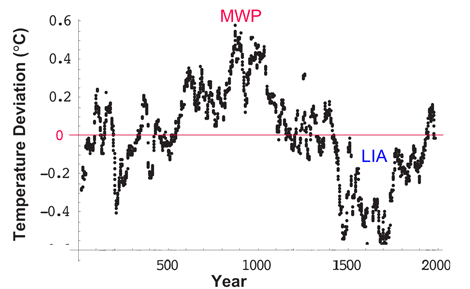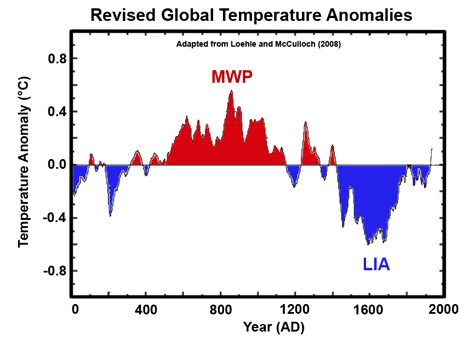Reference
Loehle, C. 2007. A 2000-year global temperature reconstruction based on non-treering proxies. Energy and Environment 18: 1049-1058.
What was done
Using data from eighteen 2000-year-long proxy temperature series from all around the world that were not developed from tree-ring data (which provide significant interpretive challenges), the author (1) smoothed the data in each series with a 30-year running mean, (2) converted the results thereby obtained to anomalies by subtracting the mean of each series from each member of that series, and then (3) derived the final mean temperature anomaly history defined by the eighteen data sets by a simple averaging of the individual anomaly series, a procedure that he rightfully emphasizes is "transparent and simple."
What was learned
The results obtained by this procedure are depicted in the figure below, where it can be seen, in the words of its creator, that "the mean series shows the Medieval Warm Period (MWP) and Little Ice Age (LIA) quite clearly, with the MWP being approximately 0.3°C warmer than 20th century values."

Mean relative temperature history of the globe. Adapted from Loehle (2007).
What it means
Loehle notes that "the 1995-year reconstruction shown here does not match the famous hockey stick shape," which clearly suggests that one of them is a poorer, and the other a better, representation of the truth. Because of its simplicity and transparency, as well as a host of other reasons described in detail by Loehle -- plus what we have learned since initiating our Medieval Warm Period Record-of-the Week feature -- it is our belief that Loehle's curve is by far the superior of the two in terms of the degree to which it likely approximates the truth.
Note
Minutes after posting this Climate Review, we received an email from Craig Loehle with an attached paper entitled:
Loehle, C. and McCulloch, J.H. 2008. Correction to: A 2000-year global temperature reconstruction based on non-tree ring proxies. Energy & Environment 19: 93-100.
The new paper describes corrections "for various errors and data issues" associated with the Loehle (2007) paper, which leads to the adjusted results depicted in the figure below.

Mean relative temperature history of the globe. Adapted from Loehle and McCulloch (2008).
In reference to the new results, Loehle and McCulloch report that the peak value of the MWP (which represents a 29-year-mean) is 0.526°C above the mean of the entire period, which places it 0.412°C above the last reported 29-year-mean value of 0.114°C at 1935 (which includes data through 1949). They then state that "while instrumental data are not strictly comparable, the rise in 29-year-smoothed global data from NASA GISS from 1935-1992 (with data from 1978 to 2006) is 0.34°C," and that "adding this rise to the 1935 reconstructed value, the MWP peak remains 0.07°C above the end of the 20th-century values, though the difference is not significant."
Reviewed 30 January 2008



